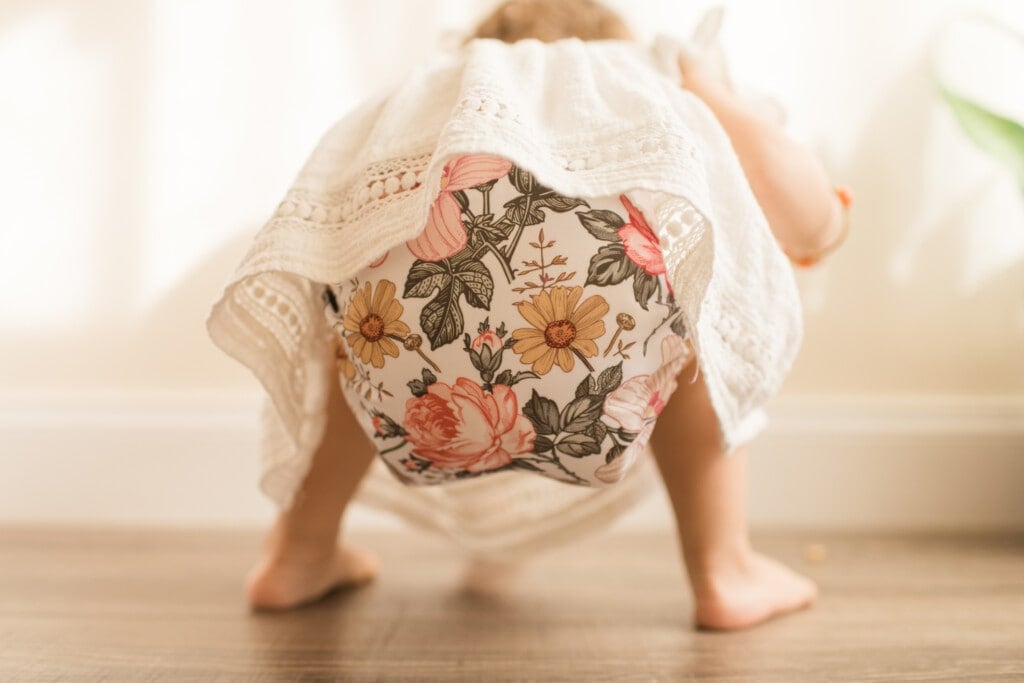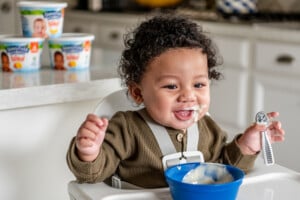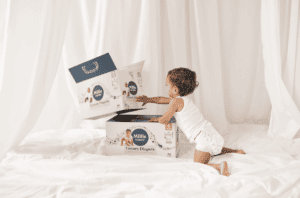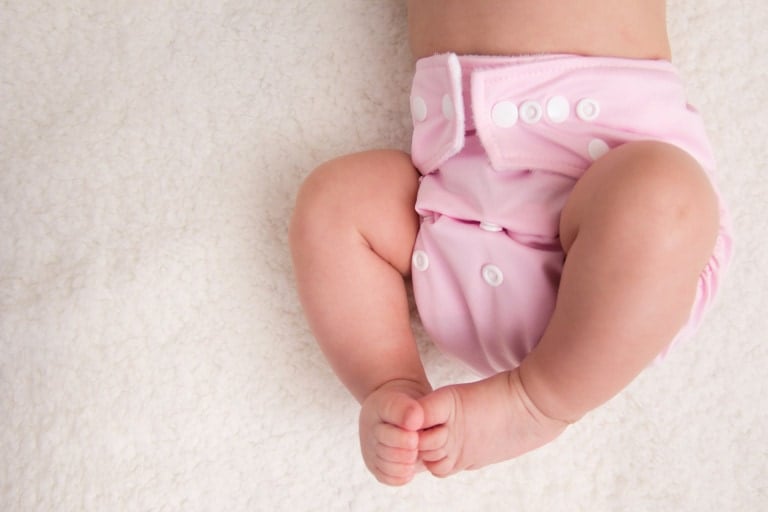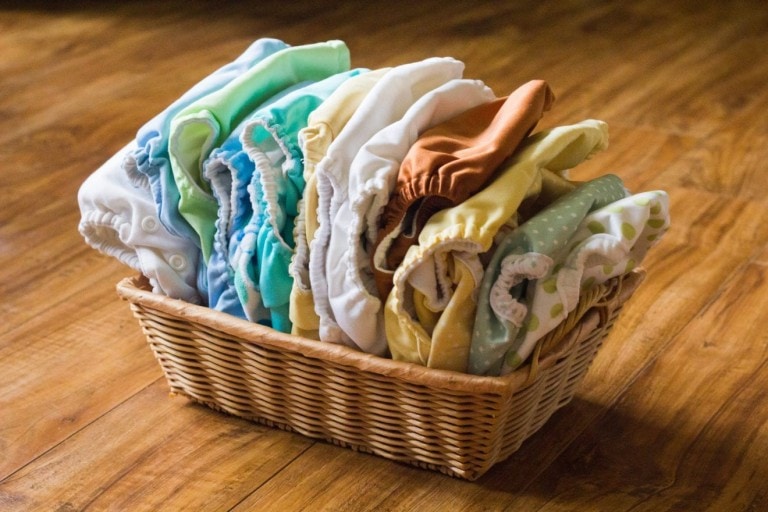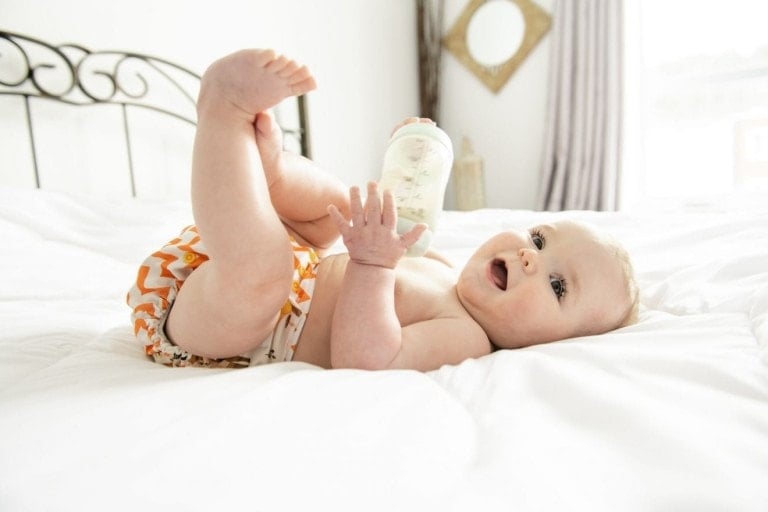Choosing the right diaper for your baby’s gentle and delicate skin can be challenging. I mean, there are so many options! If cloth diapering has ever crossed your mind, I am sharing why you shouldn’t be afraid to cloth diaper your baby. I promise it’s not too scary!
Cloth diapering kind of gets a bad rep. Mainly because, well, it’s messy. The thing is, it doesn’t always have to be messy! Most parents who cloth diaper their little ones have developed a system that works for them. A system that avoids the mess and keeps everyone (including your hands) clean throughout the process.
Pros and Cons of Cloth Diapering
Before choosing cloth diapers over disposable diapers, you should know the pros and cons of cloth diapering. Once you go through this list, I’m confident you will not be afraid to cloth diaper!
Pros of Cloth Diapering
There are some pretty great positives to choosing to use cloth diapers for your baby, including:
1. Cloth Diapers Can Save You a Ton of Money
I bet you didn’t realize just how much money you could save by switching from disposable diapers to cloth diapers!
So here’s the deal, you do spend much more upfront when it comes to cloth diapering. For example, anticipate paying around $10-$20 per cloth diaper for your little one. Then, figure out how many diapers your little one typically goes through each day. Multiply that number by the cost, and you have an estimated upfront cost of cloth diapers.
The good news is that you can save money by not buying the most expensive cloth diapers immediately and only buying what you need. However, you may run a few extra loads of laundry if you don’t get enough.
2. Cloth Diapers Contain Significantly Less Harmful Chemicals
One of the biggest reasons parents opt for cloth diapering over disposable diapering is not always to save on cost but to save their baby’s delicate skin from harmful chemicals. Disposable diapers are known to contain some pretty questionable ingredients like:
- Dioxin — a byproduct of the bleaching process to get those bright white diapers. They’re a big no-no because the EPA (Environmental Protection Agency) has made it very clear that you should avoid this cancer-causing agent.1
- Phthalates — another harmful chemical known for its “negative effect on the development of the male reproductive system.”2
- Added Fragrances — these smell-good additives might make your baby’s diaper smell powdery fresh, but the added scents can irritate their delicate skin and not to mention flare up some allergies at the same time.
By choosing to cloth diaper, you can get the best of both worlds by avoiding these unnecessary harmful chemicals while absorbing your baby’s messy eliminations.
3. They’re Great for the Environment
One of the biggest takeaways to consider when choosing to use cloth diapers is how great they are for the environment. Fortunately, cloth diapers use about 20 times fewer materials than disposables when manufacturing them. Plus, an estimated 20 BILLION disposable diapers are taken to landfills each year, introducing pathogens into the environment (such as drinking water). Yuck!
4. Many Cloth Diapers Come In Adorable Patterns, Sizes, and Materials
If you thought Honest diapers were the only diapers that came in adorable patterns, don’t check cloth diapers entirely off your list yet! Cloth diapers come in a HUGE variety of designs, sizes, and materials, making it easy to find the absolute best comfortable fit for your little one. For example, if you love animals, this reusable forest animal diaper set might be what you’re looking for! If vibrant colors are your jam, this adorable, vibrant fruit patterned set is perfect!
5. Reusable Diapers Can Promote Potty Training (For Some Children)
This little trick doesn’t always work, but the idea behind it is that young children usually don’t like the feeling of sitting with wet fabric or material against their skin. I mean, who would, right?
So with disposable diapers, that sensation of “hey, there’s a wetness on me” isn’t as obvious because diapers do an excellent job absorbing their urine and keeping their skin dry, unlike reusable diapers. While absorbent, they don’t keep the skin nearly as dry as disposable diapers. This may lead your little one to tell you they need to be changed or go potty and prepare them well for the potty training adjustment.
Cons of Cloth Diapering
Now that you know why you shouldn’t be afraid to cloth diaper, let us not avoid the fact that they aren’t perfect and come with some flaws, such as:
1. They Can Be Messy If You’re Not Careful
Cleaning up a blowout from a reusable diaper can be pretty gross. The work is easy if your baby is little and has liquid poops. If your baby has more thick, mushy, or solid poops — you’ll have to put in some careful work to shake or scrape off the mess before tossing them into the wash.
Here’s a Simple System for Cleaning a Dirty Poopie Diaper:
- Remove any solid waste by shaking, wiping, or using a diaper sprayer.
- Place the dirty diaper into a soiled bin (similar to a diaper genie) until you’re ready to run your wash.
- Run the wash every 1 to 2 days at most. Be sure to run them through with an “extra rinse” to ensure you get all the stinky mess off those diapers for good!
2. Cloth Diapers Require More Maintenance on Your Part
It’s true. You can’t just take the diaper off and toss it into a diaper pail. Instead, you have to go through a much longer process to ensure they’re ready to go into the soiled bin and then wash them every 1 to 2 days. If you wash your soiled diapers past the second day, know you increase the chance of having a harder time getting the smell or mess entirely out. Plus, when you leave moist diapers in a waste bin for too long, you risk dealing with mold. Nobody needs that.
3. Not Always as Absorbent as Disposable Diapers
It’s true. Cloth diapers aren’t always as absorbent as disposable diapers. You may need to pick up a few cloth diaper inserts to increase the absorbency. Not the biggest deal in the world, but it does factor into the upfront cost and adds a little more to your laundry pile.
4. They Require a Higher Upfront Cost
As mentioned earlier, cloth diapers do cost much more upfront. You can get set with some cloth diapers, cloth diaper inserts, and a few waste bin bags for approximately $275 – $300. In contrast, a large box of diapers might cost you $45 and last 1-2 months.
Just remember, the upfront cost pays itself off and starts saving you money around the end of the first year. When you account for the recurring cost of diapers and wipes, that’s one recurring fee you get to avoid in the future.
5. Harder to Use When Out and About
Here’s another challenge with cloth diapering: the lack of absorbency and managing those messy blowouts when you’re out and about. This is where having a portable diaper washer comes in handy to wash off the diaper and a little baggie to place it in until you’re home. You can even get away with using doggie waste bags, as they can sometimes run a little cheaper per roll.
Cloth diapering can be a handful (pun intended), but it’s pretty evident they have many benefits you shouldn’t ignore. Plus, despite having to front a higher upfront cost to get them, you will save A LOT more in the long run—a few hundreds of dollars compared to disposable diapers. At the end of the day, we have to make the best choice for your baby and family. But you shouldn’t be afraid to cloth diaper!
Have you ever tried cloth diapering? What was your experience like?













